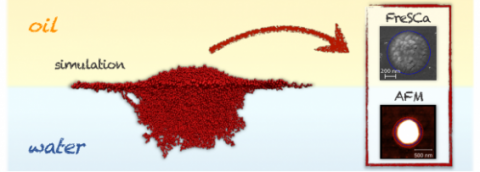Microgels Adsorbed at Liquid-Liquid Interfaces: A Joint Numerical and Experimental Study

A team of researchers, directed by Dr. Emanuela Zaccarelli from CNR-ISC at Sapienza University of Rome and by Prof. Dr. Lucio Isa from ETH Zurich, has recently studied single microgel particles adsorbed at fluid-fluid interfaces. Microgels are thermoresponsive cross-linked polymer networks whose size ranges from tens to hundreds of nanometers. At fluid interfaces, which constitute ideal settings in which nanocomposites and colloidal particles can accumulate and self-assemble, their intrinsic elasticity allows them to deform and flatten to maximize their area, reduce nonfavorable contacts between the two liquids, and thus lower the surface tension. As a result, the peculiar conformation of microgels at liquid−liquid interfaces is usually referred to as a “fried-egg” shape (see Figure).
By exploiting a newly developed model that reproduces in silico the internal polymeric architecture and single-particle properties of microgel colloids, the team has provided a comprehensive modeling of a single microgel particle at a flat water/oil interface. Up to this moment, the internal polymeric network was not taken into account in a realistic way. Numerical results obtained in Rome are directly compared with the outcomes of the experiments performed in Zurich, where microgels are imaged in situ at the water/oil interface using a cryo-scanning electron microscopy or are inspected after deposition from the interface onto a silicon wafer by means of atomic force microscopy. A good agreement between simulations and experiments has been retrieved for different microgels.
This study, recently published in ACS Nano, paves the way to a systematic microscopic investigation of soft particles at fluid interfaces. From a fundamental point of view, it constitutes the basis for the numerical study of more complex assemblies and for the investigation of the physical origin of quasi-two-dimensional structures. From a broader perspective, this study shows that it is possible to develop the predictive power required to guide experiments in designing microgels for a vast range of applications, including the stabilization of smart emulsions, the versatile patterning of surfaces and development of new nano- and micro-structured materials.
Link to the original publication:
Fabrizio Camerin, Miguel Angel Fernández-Rodríguez, Lorenzo Rovigatti, Maria-Nefeli Antonopoulou, Nicoletta Gnan, Andrea Ninarello, Lucio Isa, Emanuela Zaccarelli,
Microgels Adsorbed at Liquid-Liquid Interfaces: A Joint Numerical and Experimental Study, ACS NANO 2019,
DOI: 10.1021/acsnano.9b00390
